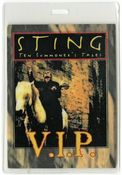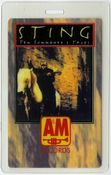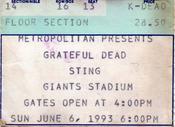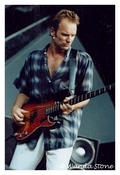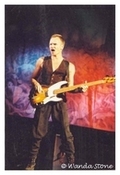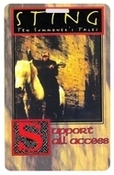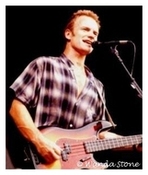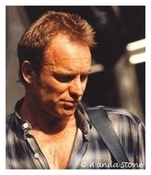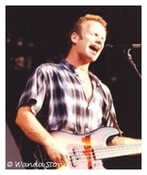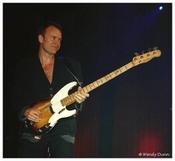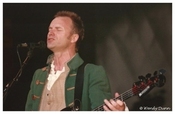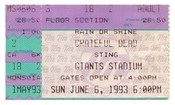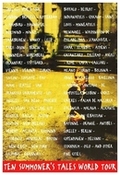
A Glimpse Of the Dead Of Old, With Sting...
Over the years, the Grateful Dead's main musical problem in concert has been consistency: it can produce lapidary improvisational moments, only to join them with hours of swill. Only the faithful, there for the particularly Californian dream of transcendence the band sells for a living, can overlook the boredom and sluggishness the band has perfected.
At Giants Stadium in East Rutherford, N.J., on a rainy Saturday night, at the first of two sold-out shows there, the Dead turned in what must be a rare thing, a whole three-hour concert that rarely flagged. The rhythm section meshed well, the singers, Jerry Garcia and Bob Weir, sang in tune and even harmonized without rough edges, and Mr. Garcia's improvisations, which can plod along at 15 miles an hour, actually hurried, as if he were trying to get somewhere. Mr. Garcia, who was hospitalized for exhaustion in August, has recently been on a regimen of exercise and a prescribed diet, and was looking fitter than he has in years.
It was a show in which the band, the product of a strange cultural explosion some 30 years ago, playing music more experimental than anything heard on the popular music circuit, suddenly surfaced as something it had been, not the bloated legend it has become: a particularly smart, Americanist bar band with imagination.
And as usual, the moments of brilliance lay in the transitions, from song to improvisation, where the edges gave way, as if underscoring the anti-authoritarianism of the band's profile and the American promise of exploring uncharted terrain. The Dead opened the second half of the show with a two-song medley, starting with 'Scarlet Begonias', while all the instruments took individual, repeating patterns.
After singing the song, Mr. Garcia produced a gently lyrical improvisation, bending notes gracefully at the end of phrases, playing with the melody's notes. Suddenly the band moved into a riff, taken by Mr. Garcia and the bassist Phil Lesh, then the song gave way, its boundaries spreading out like liquid spilled on a smooth floor, but in slow motion.
After Mr. Garcia's improvisation, the band worked its way into 'Fire on the Mountain', the individual instruments moving their separate ways with pellucid simplicity until, with a jolt, they found their way into a song. Mr. Garcia, turning up the intensity, improvised again as the various band members went their way, leaving the song behind again, with Mr. Garcia's insistent rhythmic phrasing drawing a listener through the bumps and heaving of the band. Mr. Garcia matched chromatic and steely runs with wrenching, repeated, lyrical ideas, changing the tempo of his improvisations to give them texture. The band came back to the song, and, along with Mr. Garcia went into the transition riff, and the piece was over.
The Dead brought out tunes from their entire career, including harmonically and structurally complicated pieces like 'Crazy Fingers' and 'The Music Never Stopped'; 'Crazy Fingers', with its slow reggae lope and frozen, weirdly unhostile bitterness, opened up for a lazy and dreamlike solo for Mr. Garcia, until a rhythmic change spurred him into double-time leaps that led toward the long, rolling rhythms of 'Estimated Prophet'. The band was a bar band doing its job, and doing it well.
Sting opened the show, and for an often long-winded pop star, he put in a tough and concise performance. All the pop trappings were gone, no back-up singers or saxophonists, no light show or fog, just Sting, his bass and a backup band.
Where the Grateful Dead were about expansion and the possibility inherent in improvisation, Sting and his music were about editing and pop precision. With the new, lighter Sting, his music, often heavy with portentousness, seemed scaled-down and manageable, human. He sang a Beatles song, and in the middle of 'Roxanne', he improvised the lines ''rain, rain go away, come again another day.'' Even his melodies, which often sound borrowed from Gregorian chants, were invigorated by the spare rock background he gave them. Sting sounded as if he was playing in a club and having a good time doing it. It suited him, just as it suited the Grateful Dead. Unfortunately, much of the audience of Deadheads he hopes to reach on this tour had not yet shown up; the Stadium was at most a quarter full for his set.
(c) The New York Times by Peter Watrous
Sting swings as the Dead ramble on...
Sting - suave, sophisticated, and possessing impeccable pop credentials - opening for The Grateful Dead, a scruffy bunch that prides itself on spontaneity and improvisation?
As unlikely as it seems, the bill featuring rock's equivalent of the odd couple worked - for the most part - Saturday night at Giants Stadium, where Sting and the Dead began a two-night, sold-out stand.
For Sting, the pairing has allowed him the freedom to rethink some of his tightly structured arrangements. And although Sting - who will perform his own sold-out shows Tuesday and Wednesday at The Paramount in Manhattan - has done this in some of his previous solo concerts, he's never taken his musical reworkings to quite the lengths he did during his 70-minute set.
By injecting musical breathing space into songs such as 'Consider Me Gone', 'Englishman in New York', and 'Seven Days', Sting showed where his musical career began, in the jazz realm.
There was a buoyant, freewheeling jazz spirit present in these songs that owed as much to Sting's strong, assured vocals and solid bass work, as to the deft touches supplied by the top-notch band supporting him.
David Sancious, in particular, seemed to relish having the opportunity to stretch beyond the prescribed pop formulas, and his excellent, often exhilarating keyboard work enhanced and added new dimensions to 'Love Is Stronger Than Justice' and 'King of Pain'.
While Sancious was the primary beneficiary of Sting's willingness to experiment and explore, Dominic Miller and Vinnie Colaiuta had their instrumental say, as well. Miller provided the metallike guitar muscle that ripped through 'King of Pain', while Colaiuta supplied the percussive punch that propelled the Beatles 'A Day In the Life' to almost cataclysmic proportions.
But Sting, who, not surprisingly, left from his high-energy set the somber, introspective songs from his last solo effort 'The Soul Cages', knew when to cut back on the improvisation and return the pop focus to his songs.
And this is a lesson the Grateful Dead could do well to learn, as the band took some of its songs to ludicrous improvisational lengths.
The Dead portion of the show got off to a promising start, with Bob Weir sounding better than he has in a long time. Staying within his narrow range, he imparted just the right amount of gutsy anger to effectively deliver 'Hell In a Bucket'.
But the early momentum was quickly extinguished when Jerry Garcia, on lead vocals, followed with a 15-minute rendition of 'Sugar Ree'. As tight and focused as the band sounded, to stretch this simple tune to that absurd length is to invite yawns. Unfortunately, the pattern set by 'Sugar Ree' was repeated throughout the show, with the tandem of 'Scarlet Begonias' and 'Fire On the Mountain' clocking in at 20 minutes and the ever-present 'Space', the drum segment performed by Mickey Hart and Bill Kreutzmann, missing the half-hour mark by just five minutes.
The tedium that surrounded these tunes taken to ridiculous lengths wasn't helped by a performance weighted heavily in favour of slow-paced songs. Thank goodness for Weir's energized performances of the dramatic 'That's It for the Other One' and Willie Dixon's 'Wang Dang Doodle'. Without these songs, it would have been difficult to stay awake.
(c) The New Jersey Record by Barbara Jaeger
Over the years, the Grateful Dead's main musical problem in concert has been consistency: it can produce lapidary improvisational moments, only to join them with hours of swill. Only the faithful, there for the particularly Californian dream of transcendence the band sells for a living, can overlook the boredom and sluggishness the band has perfected.
At Giants Stadium in East Rutherford, N.J., on a rainy Saturday night, at the first of two sold-out shows there, the Dead turned in what must be a rare thing, a whole three-hour concert that rarely flagged. The rhythm section meshed well, the singers, Jerry Garcia and Bob Weir, sang in tune and even harmonized without rough edges, and Mr. Garcia's improvisations, which can plod along at 15 miles an hour, actually hurried, as if he were trying to get somewhere. Mr. Garcia, who was hospitalized for exhaustion in August, has recently been on a regimen of exercise and a prescribed diet, and was looking fitter than he has in years.
It was a show in which the band, the product of a strange cultural explosion some 30 years ago, playing music more experimental than anything heard on the popular music circuit, suddenly surfaced as something it had been, not the bloated legend it has become: a particularly smart, Americanist bar band with imagination.
And as usual, the moments of brilliance lay in the transitions, from song to improvisation, where the edges gave way, as if underscoring the anti-authoritarianism of the band's profile and the American promise of exploring uncharted terrain. The Dead opened the second half of the show with a two-song medley, starting with 'Scarlet Begonias', while all the instruments took individual, repeating patterns.
After singing the song, Mr. Garcia produced a gently lyrical improvisation, bending notes gracefully at the end of phrases, playing with the melody's notes. Suddenly the band moved into a riff, taken by Mr. Garcia and the bassist Phil Lesh, then the song gave way, its boundaries spreading out like liquid spilled on a smooth floor, but in slow motion.
After Mr. Garcia's improvisation, the band worked its way into 'Fire on the Mountain', the individual instruments moving their separate ways with pellucid simplicity until, with a jolt, they found their way into a song. Mr. Garcia, turning up the intensity, improvised again as the various band members went their way, leaving the song behind again, with Mr. Garcia's insistent rhythmic phrasing drawing a listener through the bumps and heaving of the band. Mr. Garcia matched chromatic and steely runs with wrenching, repeated, lyrical ideas, changing the tempo of his improvisations to give them texture. The band came back to the song, and, along with Mr. Garcia went into the transition riff, and the piece was over.
The Dead brought out tunes from their entire career, including harmonically and structurally complicated pieces like 'Crazy Fingers' and 'The Music Never Stopped'; 'Crazy Fingers', with its slow reggae lope and frozen, weirdly unhostile bitterness, opened up for a lazy and dreamlike solo for Mr. Garcia, until a rhythmic change spurred him into double-time leaps that led toward the long, rolling rhythms of 'Estimated Prophet'. The band was a bar band doing its job, and doing it well.
Sting opened the show, and for an often long-winded pop star, he put in a tough and concise performance. All the pop trappings were gone, no back-up singers or saxophonists, no light show or fog, just Sting, his bass and a backup band.
Where the Grateful Dead were about expansion and the possibility inherent in improvisation, Sting and his music were about editing and pop precision. With the new, lighter Sting, his music, often heavy with portentousness, seemed scaled-down and manageable, human. He sang a Beatles song, and in the middle of 'Roxanne', he improvised the lines ''rain, rain go away, come again another day.'' Even his melodies, which often sound borrowed from Gregorian chants, were invigorated by the spare rock background he gave them. Sting sounded as if he was playing in a club and having a good time doing it. It suited him, just as it suited the Grateful Dead. Unfortunately, much of the audience of Deadheads he hopes to reach on this tour had not yet shown up; the Stadium was at most a quarter full for his set.
(c) The New York Times by Peter Watrous
Sting swings as the Dead ramble on...
Sting - suave, sophisticated, and possessing impeccable pop credentials - opening for The Grateful Dead, a scruffy bunch that prides itself on spontaneity and improvisation?
As unlikely as it seems, the bill featuring rock's equivalent of the odd couple worked - for the most part - Saturday night at Giants Stadium, where Sting and the Dead began a two-night, sold-out stand.
For Sting, the pairing has allowed him the freedom to rethink some of his tightly structured arrangements. And although Sting - who will perform his own sold-out shows Tuesday and Wednesday at The Paramount in Manhattan - has done this in some of his previous solo concerts, he's never taken his musical reworkings to quite the lengths he did during his 70-minute set.
By injecting musical breathing space into songs such as 'Consider Me Gone', 'Englishman in New York', and 'Seven Days', Sting showed where his musical career began, in the jazz realm.
There was a buoyant, freewheeling jazz spirit present in these songs that owed as much to Sting's strong, assured vocals and solid bass work, as to the deft touches supplied by the top-notch band supporting him.
David Sancious, in particular, seemed to relish having the opportunity to stretch beyond the prescribed pop formulas, and his excellent, often exhilarating keyboard work enhanced and added new dimensions to 'Love Is Stronger Than Justice' and 'King of Pain'.
While Sancious was the primary beneficiary of Sting's willingness to experiment and explore, Dominic Miller and Vinnie Colaiuta had their instrumental say, as well. Miller provided the metallike guitar muscle that ripped through 'King of Pain', while Colaiuta supplied the percussive punch that propelled the Beatles 'A Day In the Life' to almost cataclysmic proportions.
But Sting, who, not surprisingly, left from his high-energy set the somber, introspective songs from his last solo effort 'The Soul Cages', knew when to cut back on the improvisation and return the pop focus to his songs.
And this is a lesson the Grateful Dead could do well to learn, as the band took some of its songs to ludicrous improvisational lengths.
The Dead portion of the show got off to a promising start, with Bob Weir sounding better than he has in a long time. Staying within his narrow range, he imparted just the right amount of gutsy anger to effectively deliver 'Hell In a Bucket'.
But the early momentum was quickly extinguished when Jerry Garcia, on lead vocals, followed with a 15-minute rendition of 'Sugar Ree'. As tight and focused as the band sounded, to stretch this simple tune to that absurd length is to invite yawns. Unfortunately, the pattern set by 'Sugar Ree' was repeated throughout the show, with the tandem of 'Scarlet Begonias' and 'Fire On the Mountain' clocking in at 20 minutes and the ever-present 'Space', the drum segment performed by Mickey Hart and Bill Kreutzmann, missing the half-hour mark by just five minutes.
The tedium that surrounded these tunes taken to ridiculous lengths wasn't helped by a performance weighted heavily in favour of slow-paced songs. Thank goodness for Weir's energized performances of the dramatic 'That's It for the Other One' and Willie Dixon's 'Wang Dang Doodle'. Without these songs, it would have been difficult to stay awake.
(c) The New Jersey Record by Barbara Jaeger

